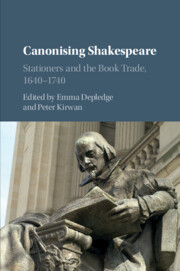Description
Canonising Shakespeare
Stationers and the Book Trade, 1640–1740
Coordinators: Depledge Emma, Kirwan Peter
This book demonstrates how the book trade of 1640–1740 canonised Shakespeare by selling, editing and promoting his plays and poems.
Language: English
Canonising Shakespeare
Publication date: 08-2022
Support: Print on demand
Publication date: 08-2022
Support: Print on demand
Canonising Shakespeare
Publication date: 09-2017
Support: Print on demand
Publication date: 09-2017
Support: Print on demand
Description
/li>Contents
/li>Biography
/li>
Canonising Shakespeare offers the first comprehensive reassessment of Shakespeare's afterlife as a print phenomenon, demonstrating the crucial role that the book trade played in his rise to cultural pre-eminence. 1640?1740 was the period in which Shakespeare's canon was determined, in which the poems resumed their place alongside the plays in print, and in which artisans and named editors crafted a new, contemporary Shakespeare for Restoration and eighteenth-century consumers. A team of international contributors highlight the impact of individual booksellers, printers, publishers and editors on the Shakespearean text, the books in which it was presented, and the ways in which it was promoted. From radical adaptations of the Sonnets to new characters in plays, and from elegant subscription volumes to cheap editions churned out by feuding publishers, this period was marked by eclecticism, contradiction and innovation as stationers looked to the past and the future to create a Shakespeare for their own times.
1. Introduction Emma Depledge and Peter Kirwan; Part I. Selling Shakespeare: 2. Shakespeare for sale, 1640–1740 Emma Depledge; 3. Royalist Shakespeare: publishers, politics and the appropriation of The Rape of Lucrece (1655) Adam G. Hooks; 4. Henry Herringman, Richard Bentley and Shakespeare's Fourth Folio (1685) Francis X. Connor; 5. Shakespeare without rules: the fifth Shakespeare folio and market demand in the early 1700s Lara Hansen and Eric Rasmussen; 6. The 1734–5 price wars, Antony and Cleopatra and the theatrical imagination Anthony Brano. Part II. Consolidating the Shakespeare Canon: 7. Consolidating the Shakespeare canon, 1640–1740 Peter Kirwan; 8. John Benson's 1640 poems and its literary precedents Faith Acker; 9. Cupids Cabinet Unlock't (1662), ostensibly 'by W. Shakespeare', in fact partly by John Milton Lukas Erne; 10. Discovering Shakespeare's personal style: editing and connoisseurship in the eighteenth century Edmund G. C. King; Part III. Editing Shakespeare: 11. Editing Shakespeare, 1640–1740 Emma Depledge and Peter Kirwan; 12. Dramatic typography and the restoration quartos of Hamlet Claire M. L. Bourne; 13. The 1709/11 editions of Shakespeare's poems Paul D. Cannan; 14. Alexander Pope, interventionist editing and The Taming of the Shrew (1725) Jonathan H. Holmes; 15. Editorial annotations in Shakespeare editions after 1733 Adam Rounce; 16. Afterword Patrick Cheney.
Emma Depledge is lecturer in Restoration and eighteenth-century literature at the Université de Fribourg, Switzerland. She has published a number of articles on Shakespeare in the Restoration and her first book explores the publication, performance and adaptation of Shakespeare's plays from 1642–1700.
Peter Kirwan is Associate Professor of Early Modern Drama at the University of Nottingham. His books include Shakespeare and the Idea of Apocrypha (Cambridge, 2015) and Shakespeare and the Digital World (Cambridge, 2014). He is currently completing a monograph on the theatre company Cheek by Jowl and new editions of Pericles and Doctor Faustus.
Peter Kirwan is Associate Professor of Early Modern Drama at the University of Nottingham. His books include Shakespeare and the Idea of Apocrypha (Cambridge, 2015) and Shakespeare and the Digital World (Cambridge, 2014). He is currently completing a monograph on the theatre company Cheek by Jowl and new editions of Pericles and Doctor Faustus.
© 2024 LAVOISIER S.A.S.
These books may interest you

Shakespeare and the Book Trade 28.98 €

Shakespeare and the Book Trade 107.81 €



